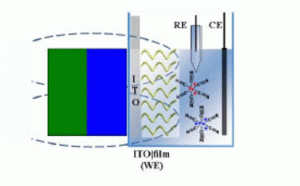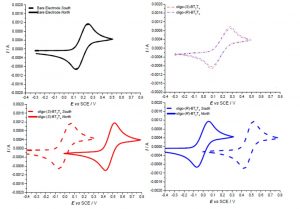A groundbreaking application of our outstanding inherently chiral electrodes has been observed in the last months.
A paper is now published on Chemical Science !!!!
Chem. Sci., 2019, Accepted Manuscript, 10.1039/C8SC04126A
Electron transfer on non-ferromagnetic electrodes coated with chiral conductive thiophene-based films resulted in an impressive shift for the half wave potential of two achiral Fe(III)/Fe(II) redox couples under external magnetic field, either upon flipping the magnetic field orientation at constant layer configuration or inverting chiral layer configuration at constant field orientation. Notably, unlike former CISS experiments, in the present case (a) the electrode support is non-ferromagnetic and, most importantly, (b) a wide potential shift as a function of the applied magnetic field is observed, rather than a current variation.

Schematic representation of the magnetoelectrochemistry experimental setup
Such unprecedented phenomenon could be linked to the peculiar semiconductor films here employed, with chirality features amplified from regioregular units to helical/foldamer macro and/or supramolecular architectures. Actually, the here reported findings parallel our recent enantiorecognition results of chiral probes on inherently chiral films in terms of potential, rather than current, difference.
Such spin-related redox potential modulation, obtained in the absence of a magnetic electrode acting as spin injector, provides a striking evidence and an attractive evaluation criterion of the spin selectivity properties of chiral thin films.
Such a novel and appealing condensed state system, of easy preparation under ambient conditions, might also be exploited as a “potentiometric” spin-sensitive sensor or a “redox” spin injector, opening the way to innovative spintronic devices.
